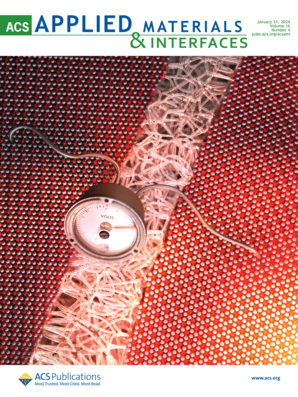From Hydrophilic to Superhydrophobic: Tuning Surface Wettability through Salvinia-Inspired Topographies.
IF 8.3
2区 材料科学
Q1 MATERIALS SCIENCE, MULTIDISCIPLINARY
引用次数: 0
Abstract
The development of superhydrophobic surfaces traditionally relies on combining surface roughness with low-surface-energy coatings. In contrast, this work demonstrates the use of two-photon polymerization to induce superhydrophobicity on hydrophilic substrates solely through structural design. A comprehensive set of Salvinia-inspired microstructures was fabricated with precise control over geometrical features such as the number of arms, arm diameter, fill configuration, spacing, and height. Static contact angle measurements revealed that surface architecture plays a pivotal role in modulating wettability, with optimized structures achieving contact angles above 160° without any chemical modification. The study further investigates how morphological fidelity, governed by two-photon polymerization (TPP) printing parameters─specifically slicing distance and hatching distance─influences surface quality, roughness, and droplet behavior. Power spectral density analysis and 3D surface topography confirm that fabrication resolution critically impacts the performance of designed features. Finally, fabrication efficiency was evaluated in terms of areal fabrication rate, highlighting trade-offs among design complexity, printing resolution, and throughput. The results establish a set of design principles for achieving superhydrophobicity on hydrophilic materials and provide a scalable framework for future applications in microfluidics, biomimetics, and surface engineering where chemical-free wettability control is desired.从亲水到超疏水:通过萨尔维尼启发的地形调整表面润湿性。
超疏水表面的发展传统上依赖于表面粗糙度和低表面能涂层的结合。相比之下,这项工作证明了使用双光子聚合仅通过结构设计在亲水底物上诱导超疏水性。一套全面的萨尔维尼启发的微结构是通过精确控制几何特征,如臂的数量、臂的直径、填充结构、间距和高度来制造的。静态接触角测量表明,表面结构在调节润湿性方面起着关键作用,优化后的结构在没有任何化学修饰的情况下实现了160°以上的接触角。该研究进一步探讨了由双光子聚合(TPP)打印参数(特别是切片距离和孵化距离)控制的形态保真度如何影响表面质量、粗糙度和液滴行为。功率谱密度分析和三维表面形貌证实,制造分辨率对设计特征的性能有重要影响。最后,根据面制造率评估了制造效率,突出了设计复杂性,打印分辨率和吞吐量之间的权衡。研究结果为在亲水材料上实现超疏水性建立了一套设计原则,并为未来在微流体、仿生学和表面工程等需要无化学润湿性控制的领域的应用提供了可扩展的框架。
本文章由计算机程序翻译,如有差异,请以英文原文为准。
求助全文
约1分钟内获得全文
求助全文
来源期刊

ACS Applied Materials & Interfaces
工程技术-材料科学:综合
CiteScore
16.00
自引率
6.30%
发文量
4978
审稿时长
1.8 months
期刊介绍:
ACS Applied Materials & Interfaces is a leading interdisciplinary journal that brings together chemists, engineers, physicists, and biologists to explore the development and utilization of newly-discovered materials and interfacial processes for specific applications. Our journal has experienced remarkable growth since its establishment in 2009, both in terms of the number of articles published and the impact of the research showcased. We are proud to foster a truly global community, with the majority of published articles originating from outside the United States, reflecting the rapid growth of applied research worldwide.
 求助内容:
求助内容: 应助结果提醒方式:
应助结果提醒方式:


